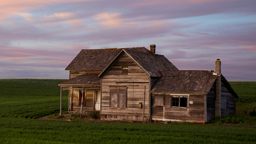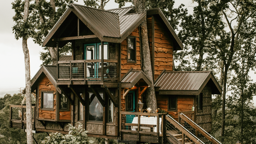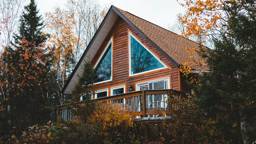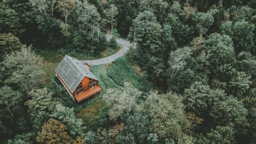
Some projects are easy to do yourself, such as a simple cleaning and re-application of the previously used wood-protection product, says Barbara Murray of CTA Products Group. Be cautious: If you can’t safely access parts of your home’s exterior, call in a pro, Murray advises. Read on for ways to keep your cabin in tip-top shape.
Drainage counts
Walk around your retreat to inspect the ground around your foundation. The soil should slope down from the cabin to promote adequate drainage away from your foundation. If the soil has compacted near your cabin since construction causing a negative slope, you may need to correct this with several yards of fresh topsoil.
Oversize your overhangs
Eaves that are at least 2 to 3 feet deep will help protect your exterior wood walls from excessive moisture and sun exposure.
Cover your gutters
A mesh cover on top of your gutters and downspouts will help keep leaves and debris out while allowing rainwater to filter through. Screening debris out will prevent moisture from backing up under the eaves and leaking inside. If your gutters need replacing, consider replacing them with ones that have leaf-blocking built in.
Apply sunblock
Like your skin, wood is susceptible to sun damage. Harsh ultraviolet (UV) rays can cause the surface of wood to break down, so consider using pigmented stains and products infused with UV combatants to protect your exterior logs, cedar siding and decking against sun damage.
Be watchful
Twice each year (spring and fall are best), walk around and inspect your cabin.- Log cabin For log walls, look for upward-facing checks (cracks in the wood), which could collect rainwater and cause damage to the logs. Also, both inside your cabin and out, look for separation in the chinking or sealant. Any gaps could let moisture and air seep in.
- Cedar siding Check boards for rotting, especially those near gutters.
- Windows Open your windows, and then walk around your cabin and thoroughly inspect the framing and sills for peeling paint or worse yet – soft wood that may need repair or replacement.
Just add water
Using a garden hose or a water bottle, spray your exterior wood surfaces – wood decking, cedar siding or log walls – in several places. If the water beads up, you’re assured that your preservative is working. If dark, wet patches appear on the wood, the water is soaking in, so it’s probably time for a fresh coat of preservative. If you own a log home and it has exposed log ends, be sure to do the water test on those, because log ends can absorb water up to 10 times the rate of horizontal log surfaces.
Watch for mold or mildew
Because your cabin’s exterior is exposed to moisture, it’s important to get rid of mold or mildew build-up, which will likely be in the form of a black or grayish-green film. Most preservatives have a mildewcide built in, but regular inspections will ensure they’re doing their job.
Keep an eye on the roof
Whatever type of roofing you have, make sure the material is in good shape, particularly around chimneys and in valleys where rooflines meet, which is where moisture and debris can collect.
Clear landscaping away
Ideally, ground cover and mulch should be at least 3 feet away from your home’s exterior wood. Doing so will keep debris, bugs and excess water away from the walls, helping to prevent mold, moisture and insect damage. Likewise, tree canopies should be kept away from your roof to help keep leaves and twigs from collecting.Wood Preservation
There are many products used to seal and protect cedar-sided, log and timber-frame cabins. Modern offerings have grown to include time-tested formulas, new colors and eco-friendly options. The table below lists major manufacturers of stains, sealants and other cabin maintenance products. Your local provider may also have recommendations based on your location and climate.
Product Types
Stain: There are three types of stain: oil-based, water-based and emulsions that blend the two. Today’s stains – available in a host of colors from gray to green, blond to dark honey – are designed not only to give a tint to your walls, but they also coat the wood with a breathable layer of protection.Preservative: A mix of chemicals designed to protect against a host of environmental threats, such as mold, mildew, ultraviolet rays and insects.
Sealant: A liquid (caulk) or solid (foam or butyl rubber) material used to prevent air or water from passing though joints.
Chinking: Chinking is a thick material used to seal the gaps between log courses. Traditional chinking is mortar-based, but modern synthetic chinking is far more elastic, effective and durable. Also, today’s chinking is available in a variety of colors, though most cabin owners prefer a white or light color to contrast with darker wooden materials.
Caulk: A sealant used to fill joints and spaces between logs. Often it’s clear or a color that matches the tone of the wood. Caulk comes in tubes or pails, and is applied with a gun in a narrow bead. The soft, moist bead dries to a tough elastic sealant that protects against air and water infiltration.
Cleaner: Several products are designed specifically for use on your cabin’s exterior and interior walls. A pressure washer with a fan tip is another way to clean your walls. Just keep the wand moving as you start at the top and work your way down.










